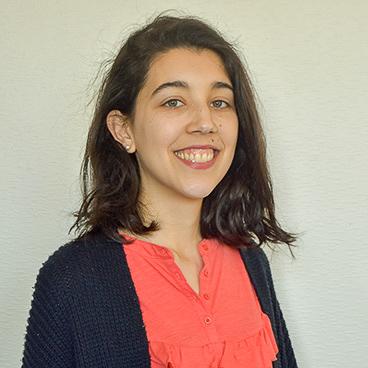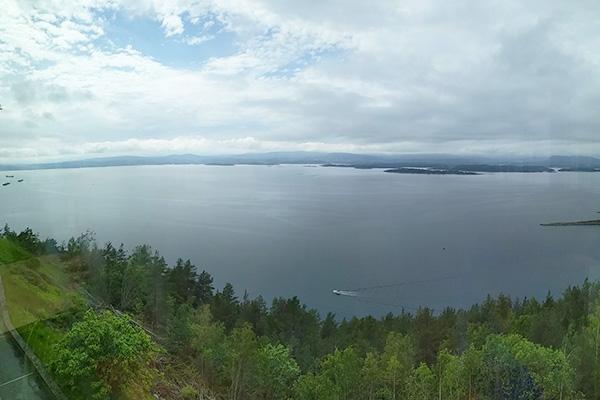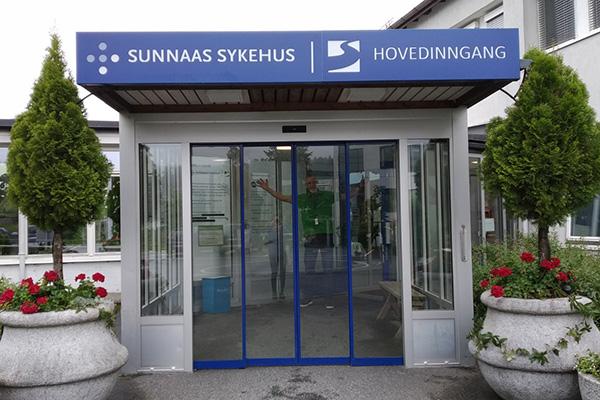
A blog post by Paola Hernández Olivan, Food Projects and Policy Officer – HCWH Europe
Oslo - the city that stole my heart for a few days thanks to our HCWH Europe member, the South-Eastern Regional Health Authority of Norway.
During my visit I not only gained a better understanding and insight into how sustainable food strategies are implemented at healthcare facilities, but also about some of the measures taken by the city of Oslo – the 2019 European Green Capital - to enhance urban environments for its citizens. I am happy to share my insights and some of the practices I discovered during this great opportunity.
Enjoying the rooftop garden at Oslo University Hospital
Just one day after the official opening overseen by Norway’s Minister for Climate and Environment, I first visited the rooftop garden of the Children's Center at Oslo University Hospital. Developed by children for children, the project encourages young patients to help create a more sustainable future (both within and outside the hospital).
With a solar powered self-irrigation system and outdoor furniture, the garden hosts a selection of fruits and vegetables such as carrots, tomatoes, and wild strawberries, as well bee-friendly flowers. This fresh and green space allows young patients and visitors to relax, socialise, and learn about growing food. Though it primarily serves as an educational and social hub, there are plans to further develop the garden so that it can provide healthier and more nutritious food to patients and staff.
The rooftop garden is an excellent example of how hospitals can serve as anchor institutions for sustainability within their communities, not only providing healthier and more sustainable food for their patients, but also raising awareness amongst the wider community.
Meeting with the regional network for environmental management
Following my visit to the rooftop garden, I met the South-Eastern Regional Network for Environmental Management. The network was created in 2012 in response to legislation introduced by the Norwegian Ministry of Health & Care Services to increase sustainability in the public health system. The ministry required all hospitals to establish environmental management programmes and to become ISO 14001 certified in environmental management by the end of 2014. Creating this network was an important step towards more effective collaboration, better exchange of information, and sharing of tools and resources.
When meeting the Regional Network for Environmental Management, I had the chance to present HCWH Europe’s work to achieve environmental and health goals across several policy areas, with a focus on our Sustainable Food programme. It was a great opportunity for us all to reflect on several different aspects of sustainable food in healthcare. We also discussed the important role that policy makers and health professionals play in the transition to sustainable food systems whilst reinforcing the links between environment, nutrition, and health.
Food procurement was a key topic that we discussed in detail; I was able to meet the Agency for Public Management and eGovernment (Difi) – who are responsible or improving government efficiency. Meeting with these stakeholders helped me to better understand how public bodies balance different interests to ensure that public procurement is both fair and sustainable. I was particularly impressed by Difi’s efforts to highlight the importance of products’ carbon footprint in procurement criteria, as well as their emphasis on ethical procurement, particularly in relation to human rights in supply chains.
Feeling at home in Hospital
With 170 beds and 750 employees, the Sunnaas Rehabilitation Hospital, primarily cares for patients in the South East Region of Norway with complex functional impairment following illness or injury, rare congenital disorders, or locked-in syndrome. The hospital’s care model focuses on community re-entry, which for many people means returning to home, work, or a supported community living environment.
One of my first stops was, of course, the canteen. In cooperation with their catering services provider, Sunnaas has committed to halving food waste and food-related emissions by 2030. To achieve this, meal sizes have been reduced, and information about environmentally-friendly food practices is readily available to patients and employees. The hospital also introduced a “smiley face” feedback system to gauge patient and staff satisfaction, and in in 2016, they launched a hugely successful “Meat-free Monday” initiative; the hospital has made a commitment in 2019 to expand this initiative to two days per week.

The view from the Sunnaas Rehabilitation Hospital canteen
What I found most striking about the hospital was how they have fully embraced nature and their surroundings, ensuring that patients are connected to the outdoors as much as possible, and that they feel “at home” during their stay. The design and layout of the hospital, give patients and visitors clear views of the outside, interior or exterior gardens, art with a nature theme, and natural light throughout. This environment was specifically designed to comfort patients and aid in their recovery and rehabilitation.
Oslo is sprouting!
Oslo has many urban farming projects - some are very well-established, whilst others have been recently initiated by public and private stakeholders. The city is really proud of these projects and, during my stay, the key role nature plays in our health and wellbeing was consistently reinforced.
Nabolagshager - an Oslo-based social enterprise and consultancy - has established many urban farming projects across the city, using beekeeping and gardening as tools to build social cohesion, increase the sense of belonging and security, and tackle climate change and environmental degradation. A local project: Tak for Maten, is an award-winning rooftop farm on top of the National Association of Farmers’ building. This pilot project, in collaboration with the Oslo Municipality Urban Environment Agency, started in 2017 with the objective to test different lightweight soil mixes, and how different plants thrive in the weather conditions on the roof - especially with the wind conditions. They have also experimented with pollinator friendly planting to accommodate bees, and rearing chickens for egg production. The project is run by technical professionals and young volunteers from the city, and also has a social function for visitors, residents, and users that includes farming tips for residents' balconies and how to use different crops, etc.
Nabolagshager also participates in a range of national and international research-oriented projects and collaborations. Two examples of these are “Cultivating Public Spaces: Urban agriculture as a basis for human flourishing and sustainability transition in Norwegian cities”, which is led by the Norwegian University for Life Sciences, and the Horizon2020-project “Integrating Edible City Solutions for social resilient and sustainably productive cities”, lead by Technische Universität Berlin in Germany.
During my visit, I was inspired by how the South-Eastern Regional Health Authority is working to reinforce the linkages between environment and health, and collaborating across sectors to incite policy change to build a more sustainable future for everyone.
A key element is rethinking our connection with food, particularly in healthcare, where it should be seen as an investment in the health and well being of patients, staff, communities, and the planet.
Food is the cornerstone of every culture, and Norway is no exception. My hands-on experience has proven to be enriching to my work at HCWH, and I am looking forward to continuing our collaboration with the South-Eastern Regional Health Authority. I will be sharing the best practices I have learned about during with our members across Europe to inspire many other hospitals to recognise the value of nutritious and sustainable food as an early, upstream health intervention. These case studies will be shared with our Global Green and Healthy Hospitals network.

Thanks to the South-Eastern Regional Health Authority, and particularly to David Brasfield, Environmental Manager at Sunnaas Rehabilitation Hospital for his guidance, enthusiasm, and support in making this placement possible.